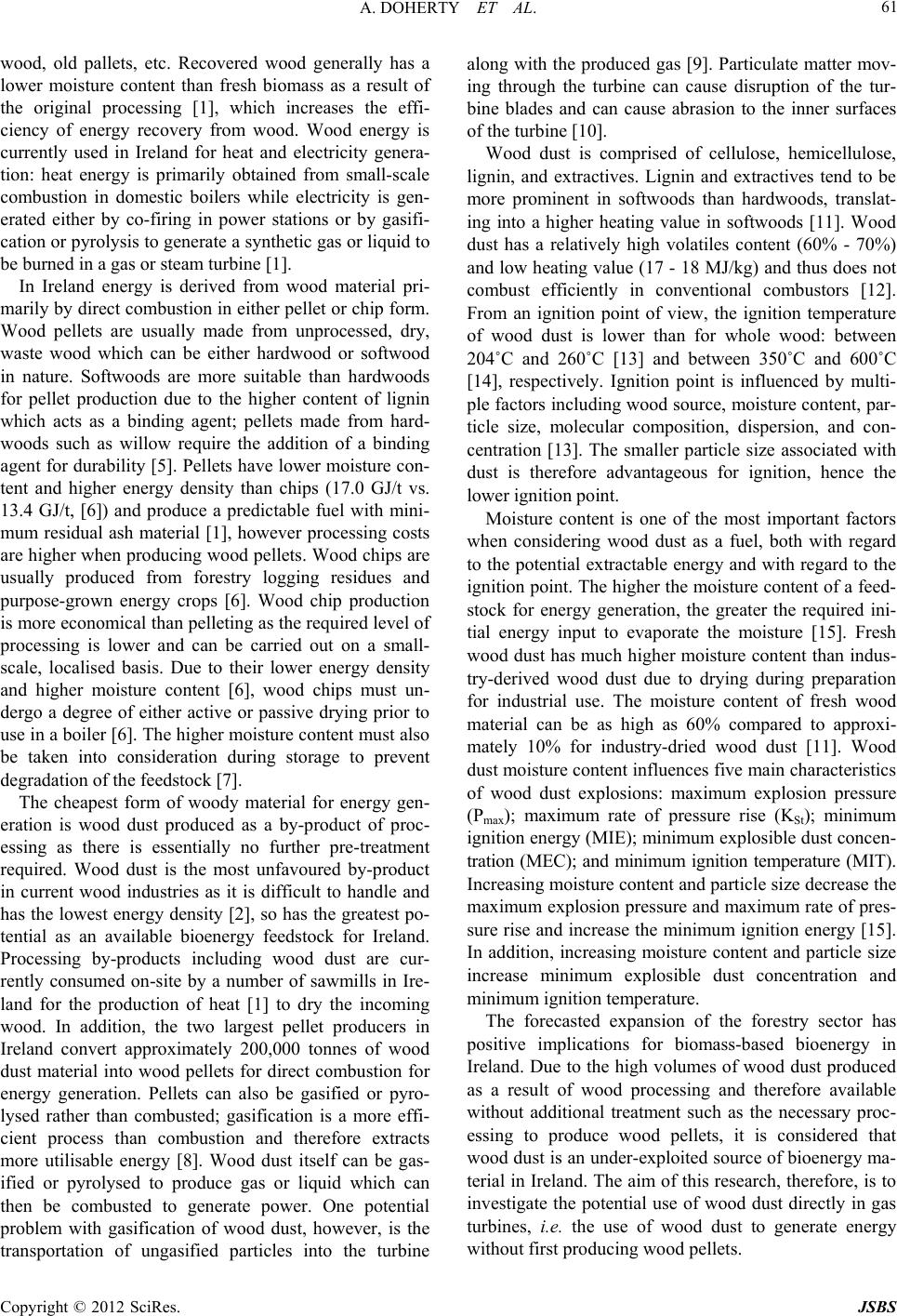
A. DOHERTY ET AL. 61
wood, old pallets, etc. Recovered wood generally has a
lower moisture content than fresh biomass as a result of
the original processing [1], which increases the effi-
ciency of energy recovery from wood. Wood energy is
currently used in Ireland for heat and electricity genera-
tion: heat energy is primarily obtained from small-scale
combustion in domestic boilers while electricity is gen-
erated either by co-firing in power stations or by gasifi-
cation or pyrolysis to generate a synthetic gas or liquid to
be burned in a gas or steam turbine [1].
In Ireland energy is derived from wood material pri-
marily by direct combustion in either pellet or chip form.
Wood pellets are usually made from unprocessed, dry,
waste wood which can be either hardwood or softwood
in nature. Softwoods are more suitable than hardwoods
for pellet production due to the higher content of lignin
which acts as a binding agent; pellets made from hard-
woods such as willow require the addition of a binding
agent for durability [5]. Pellets have lower moisture con-
tent and higher energy density than chips (17.0 GJ/t vs.
13.4 GJ/t, [6]) and produce a predictable fuel with mini-
mum residual ash material [1], however processing costs
are higher when producing wood pellets. Wood chips are
usually produced from forestry logging residues and
purpose-grown energy crops [6]. Wood chip production
is more economical than pelleting as the required level of
processing is lower and can be carried out on a small-
scale, localised basis. Due to their lower energy density
and higher moisture content [6], wood chips must un-
dergo a degree of either active or passive drying prior to
use in a boiler [6]. The higher moisture content must also
be taken into consideration during storage to prevent
degradation of the feedstock [7].
The cheapest form of woody material for energy gen-
eration is wood dust produced as a by-product of proc-
essing as there is essentially no further pre-treatment
required. Wood dust is the most unfavoured by-product
in current wood industries as it is difficult to handle and
has the lowest energy density [2], so has the greatest po-
tential as an available bioenergy feedstock for Ireland.
Processing by-products including wood dust are cur-
rently consumed on-site by a number of sawmills in Ire-
land for the production of heat [1] to dry the incoming
wood. In addition, the two largest pellet producers in
Ireland convert approximately 200,000 tonnes of wood
dust material into wood pellets for direct combustion for
energy generation. Pellets can also be gasified or pyro-
lysed rather than combusted; gasification is a more effi-
cient process than combustion and therefore extracts
more utilisable energy [8]. Wood dust itself can be gas-
ified or pyrolysed to produce gas or liquid which can
then be combusted to generate power. One potential
problem with gasification of wood dust, however, is the
transportation of ungasified particles into the turbine
along with the produced gas [9]. Particulate matter mov-
ing through the turbine can cause disruption of the tur-
bine blades and can cause abrasion to the inner surfaces
of the turbine [10].
Wood dust is comprised of cellulose, hemicellulose,
lignin, and extractives. Lignin and extractives tend to be
more prominent in softwoods than hardwoods, translat-
ing into a higher heating value in softwoods [11]. Wood
dust has a relatively high volatiles content (60% - 70%)
and low heating value (17 - 18 MJ/kg) and thus does not
combust efficiently in conventional combustors [12].
From an ignition point of view, the ignition temperature
of wood dust is lower than for whole wood: between
204˚C and 260˚C [13] and between 350˚C and 600˚C
[14], respectively. Ignition point is influenced by multi-
ple factors including wood source, moisture content, par-
ticle size, molecular composition, dispersion, and con-
centration [13]. The smaller particle size associated with
dust is therefore advantageous for ignition, hence the
lower ignition point.
Moisture content is one of the most important factors
when considering wood dust as a fuel, both with regard
to the potential extractable energy and with regard to the
ignition point. The higher the moisture content of a feed-
stock for energy generation, the greater the required ini-
tial energy input to evaporate the moisture [15]. Fresh
wood dust has much higher moisture content than indus-
try-derived wood dust due to drying during preparation
for industrial use. The moisture content of fresh wood
material can be as high as 60% compared to approxi-
mately 10% for industry-dried wood dust [11]. Wood
dust moisture content influences five main characteristics
of wood dust explosions: maximum explosion pressure
(Pmax); maximum rate of pressure rise (KSt); minimum
ignition energy (MIE); minimum explosible dust concen-
tration (MEC); and minimum ignition temperature (MIT).
Increasing moisture content and particle size decrease the
maximum explosion pressure and maximum rate of pres-
sure rise and increase the minimum ignition energy [15].
In addition, increasing moisture content and particle size
increase minimum explosible dust concentration and
minimum ignition temperature.
The forecasted expansion of the forestry sector has
positive implications for biomass-based bioenergy in
Ireland. Due to the high volumes of wood dust produced
as a result of wood processing and therefore available
without additional treatment such as the necessary proc-
essing to produce wood pellets, it is considered that
wood dust is an under-exploited source of bioenergy ma-
terial in Ireland. The aim of this research, therefore, is to
investigate the potential use of wood dust directly in gas
turbines, i.e. the use of wood dust to generate energy
without first producing wood pellets.
Copyright © 2012 SciRes. JSBS